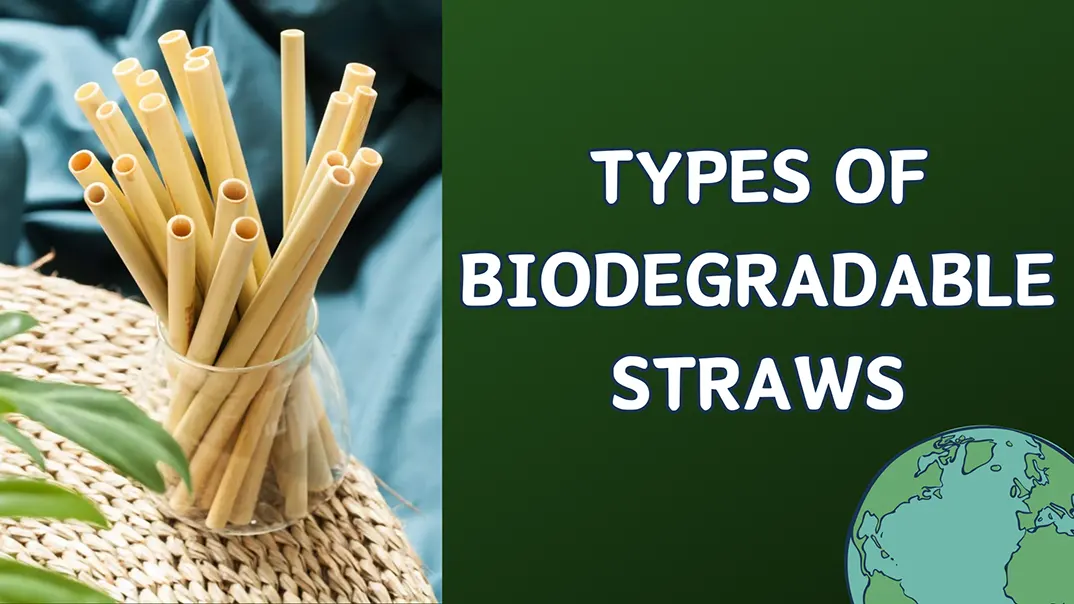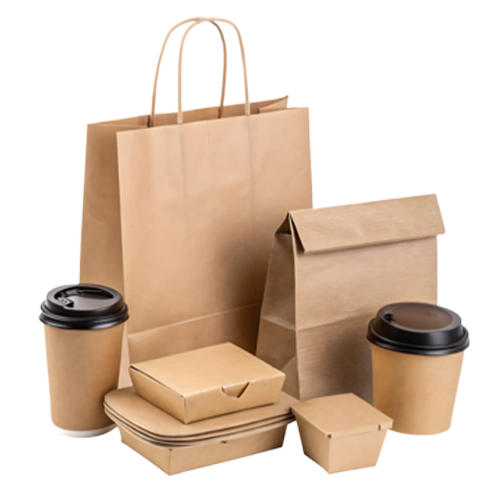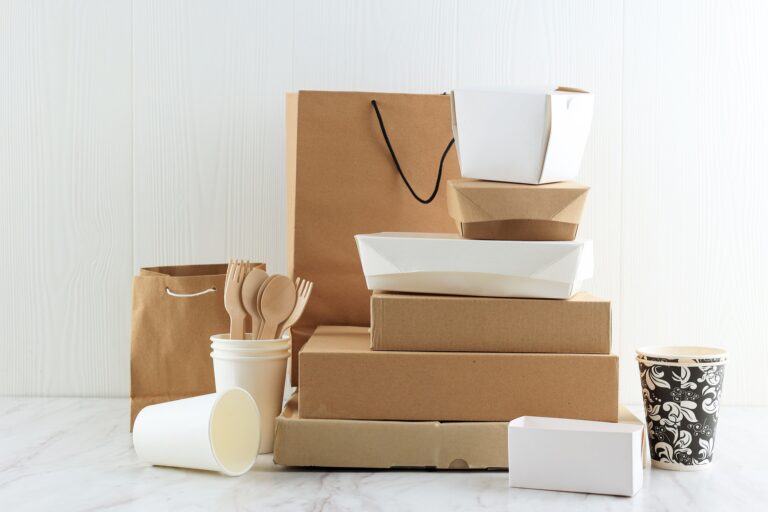Plastic straws have long been a convenient option for both consumers and businesses, but their environmental impact is undeniable. Millions end up in landfills and oceans, polluting ecosystems and harming marine life.
That’s where biodegradable straws come in. Designed to decompose naturally in the environment, these straws offer a cleaner, more sustainable solution. However, with so many new materials on the market, it can be difficult to understand what types of biodegradable straws are available and which are truly effective.
This article breaks down the different types of biodegradable straws, comparing their features, pros and cons, and ideal use cases. Whether you’re an eco-conscious consumer or a business looking to make a change, this guide will help you make informed, sustainable decisions.
What are Biodegradable Straws?
Biodegradable straws are drinking straws made from natural or plant-based materials that can break down into non-toxic components under specific environmental conditions. Unlike traditional plastic straws, which can persist in the environment for hundreds of years, biodegradable straws are designed to decompose more quickly and safely, minimizing long-term waste and pollution.
These straws are typically made from materials such as paper, cornstarch-based PLA (polylactic acid), bamboo, wheat, sugarcane, or rice. Depending on the material, they may degrade in industrial composting facilities or even in home composting setups. However, the speed and completeness of biodegradation vary based on the material and environmental factors like temperature, moisture, and microbial activity.
The primary goal of biodegradable straws is to reduce reliance on fossil-fuel-based plastics and offer a sustainable alternative that aligns with modern environmental standards. While not all biodegradable straws are compostable or marine-safe, they represent a significant step toward reducing single-use plastic waste in food service and everyday consumption.
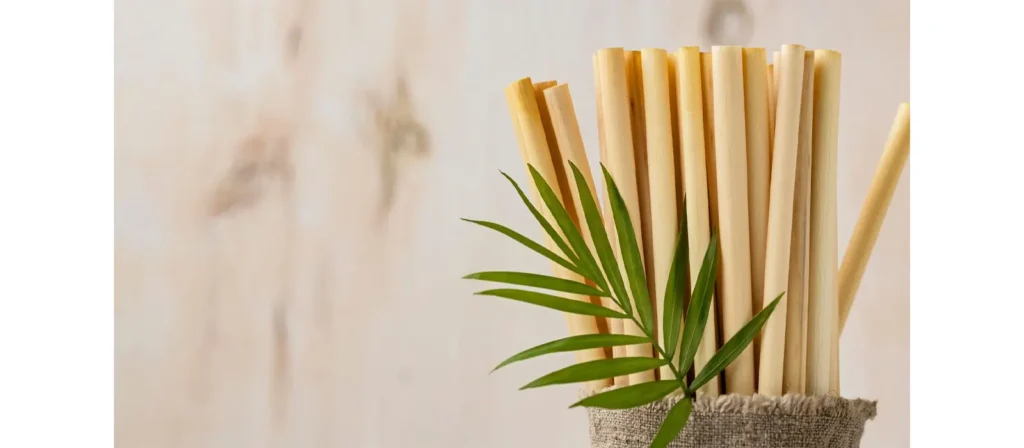
The History of Biodegradable Straws
The story of biodegradable straws is closely linked to the broader evolution of drinking straws themselves. Early straws date back thousands of years, with evidence showing that ancient Mesopotamians used hollow reed or gold tubes to drink beer from clay vessels. These early tools were natural and fully biodegradable, but they were not produced on a large scale.
The modern straw era began in the late nineteenth century when paper straws were introduced as a sanitary alternative to natural reeds. In 1888, American inventor Marvin Stone patented the first mass-produced paper straw, which quickly gained popularity in soda fountains and cafes. However, the mid-twentieth century brought a major shift when petroleum-based plastics became widely available. Plastic straws were cheap, strong, and easy to manufacture, and they rapidly replaced paper as the industry standard.
By the early twenty-first century, the environmental cost of single-use plastics had become impossible to ignore. Plastic straws were found polluting oceans, harming marine life, and contributing to the global waste crisis. These concerns triggered a growing movement toward sustainable alternatives, leading manufacturers and scientists to revisit biodegradable materials.
Over the past two decades, innovation in material science has driven the development of new types of biodegradable straws made from sources such as cornstarch-based PLA, PHA derived from microbial fermentation, and plant fibers like bamboo and wheat. Government bans on single-use plastics, consumer demand for eco-friendly solutions, and corporate sustainability goals have accelerated this transformation. What began as a niche alternative has now become a mainstream choice, with biodegradable straws symbolizing the shift toward a more responsible and circular approach to everyday products.
The EU Plastics Ban and the Rise of Biodegradable Straws
The European Union has taken a leading role in the global movement to reduce single-use plastic pollution, and its policies are now shaping the future of sustainable food service. In July 2021, the EU introduced the Single-Use Plastics Directive (SUPD), which officially banned several disposable plastic items including drinking straws, stirrers, cutlery, and plates. This directive aims to reduce marine pollution, limit landfill waste, and encourage the development of eco-friendly alternatives.
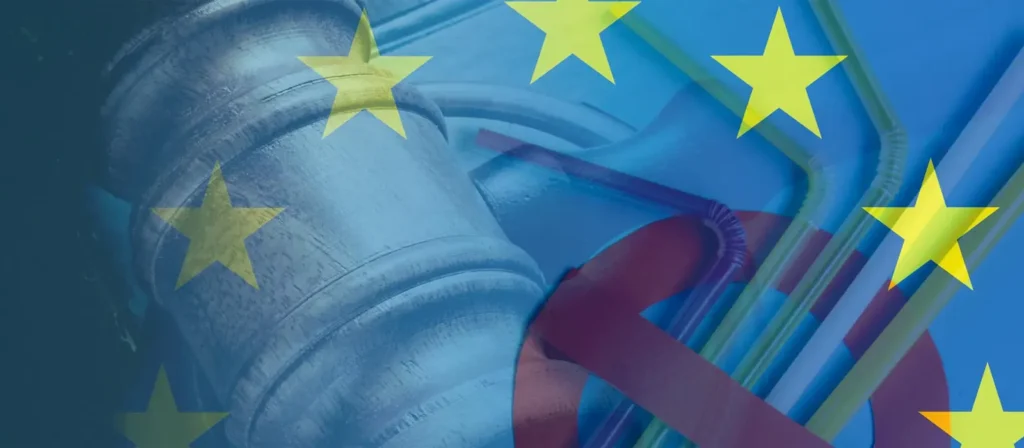
Today, the ban is fully enforced across all EU member states. Companies that continue to use traditional plastic straws face significant penalties, and imported products that do not comply with the regulation are restricted at the border. Member states have also implemented additional measures, such as mandatory labeling requirements, extended producer responsibility schemes, and national recycling targets. These policies reflect the EU’s long-term strategy to transition toward a circular economy and significantly cut down on single-use plastic consumption.
As a result, biodegradable straws have become more than just an environmentally friendly option. They are now a legal necessity for any food and beverage business operating in the European market. Manufacturers are responding to this demand by expanding the range of available options, including paper, PHA, PLA, reed, bamboo, and sugarcane straws. Each material offers different levels of durability, compostability, and performance, making it essential to understand the various types of biodegradable straws before choosing the most suitable one for your business.
The success of the EU’s legislation has also influenced other regions. Countries such as Canada, the United Kingdom, and Australia have introduced similar bans, and many U.S. states and cities are following the same path. This global trend shows that biodegradable straws are no longer a niche alternative but a mainstream solution for complying with regulations and meeting growing consumer expectations for sustainable products.
Plastic Straws vs Biodegradable Straws
To understand the environmental and practical implications of switching from plastic to biodegradable straws, the following table compares their key characteristics across several dimensions:
| Aspect | Plastic Straws | Biodegradable Straws |
|---|---|---|
| Material Composition | Petroleum-based synthetic polymers such as polypropylene or polystyrene | Plant-based materials such as paper, PLA, bamboo, wheat, or sugarcane |
| Environmental Impact | Non-biodegradable, contributes to long-term pollution in land and marine habitats | Breaks down naturally under certain conditions, reducing long-term waste |
| Decomposition Time | Can take hundreds of years to degrade | May degrade within weeks to months depending on material and composting environment |
| Recyclability | Technically recyclable but rarely processed due to small size and contamination | Often compostable but requires correct disposal conditions to fully break down |
| Durability in Use | Highly durable, resistant to heat and liquids | Varies by material; some may soften or break down in hot or acidic beverages |
| Cost to Produce | Generally low-cost due to mass production and established supply chains | Higher cost due to material sourcing and limited production scale |
| User Experience | Familiar texture and functionality | Some users may notice differences in texture or taste depending on the material used |
| End-of-Life Outcome | Persists in landfills or the environment without breaking down | Decomposes into natural components with minimal environmental harm when properly treated |
The Benefits of Biodegradable Straws
Biodegradable straws offer a range of environmental and practical benefits that make them a preferred alternative to traditional plastic straws. As more consumers and businesses seek sustainable options, the appeal of biodegradable materials continues to grow.
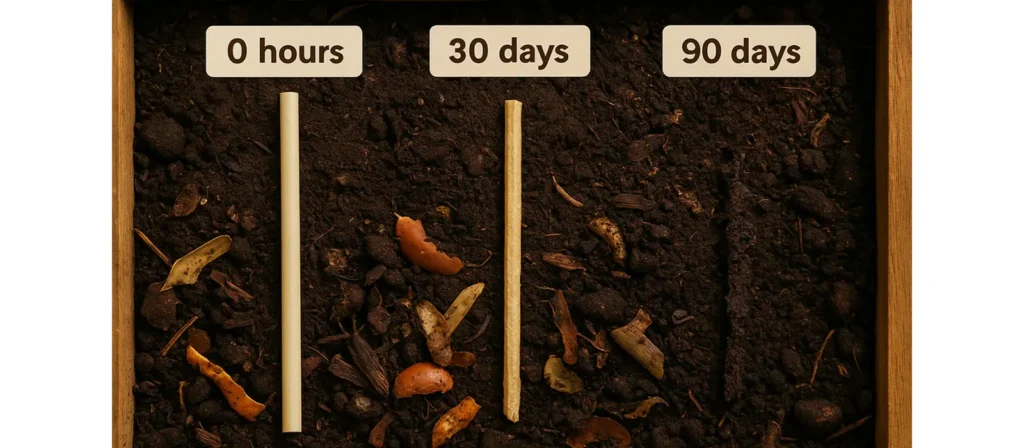
Faster Decomposition and Reduced Pollution
Biodegradable straws are designed to break down into natural components much faster than traditional plastic straws. While plastic can persist in the environment for hundreds of years, biodegradable alternatives can decompose within weeks or months under the right conditions. This helps reduce landfill waste, marine pollution, and the long-term ecological footprint associated with disposable products.
Made from Renewable Plant-Based Materials
Unlike petroleum-based plastics, biodegradable straws are often manufactured from renewable resources such as bamboo, paper, sugarcane fiber, cornstarch, or wheat. These materials are typically more sustainable because they can be regrown and harvested seasonally. This reduces dependence on fossil fuels and supports the development of greener supply chains.
Compliance with Environmental Regulations
Many countries and regions have implemented strict bans or limitations on the use of single-use plastics. Biodegradable straws provide a practical solution for businesses aiming to comply with these laws. Whether for local ordinances or international export standards, switching to biodegradable options ensures legal compliance without sacrificing product usability.
Positive Brand Image and Customer Loyalty
Businesses that choose eco-friendly alternatives often enjoy stronger brand recognition and customer loyalty. Consumers are increasingly drawn to companies that prioritize sustainability and environmental responsibility. Offering biodegradable straws can enhance your brand image and appeal to a growing market segment that values ethical and environmentally conscious practices.
Safe for Use in Food and Beverage Services
Biodegradable straws are typically certified for food contact and are safe to use with a wide range of drinks, including cold, warm, or mildly acidic beverages. While performance may vary depending on the material, many biodegradable straws now offer durability and comfort that rivals or even exceeds that of conventional plastic straws.
What Are The Different Types of Biodegradable Straws?
Biodegradable straws come in a variety of materials, each offering unique properties in terms of sustainability, durability, and user experience. Understanding the full range of available options can help consumers and businesses choose the most suitable type based on environmental goals and practical needs. Here are the most common types of biodegradable straws currently in use:
1. Paper Straws
Paper straws are one of the earliest and most widely adopted alternatives to plastic straws. They are made from layers of food-grade paper bonded with biodegradable adhesives, often using water-based glues. These straws are designed to break down quickly in both industrial and home composting environments. With growing legislation against plastic straws, paper has become a go-to solution for many businesses due to its affordability, accessibility, and ease of disposal.
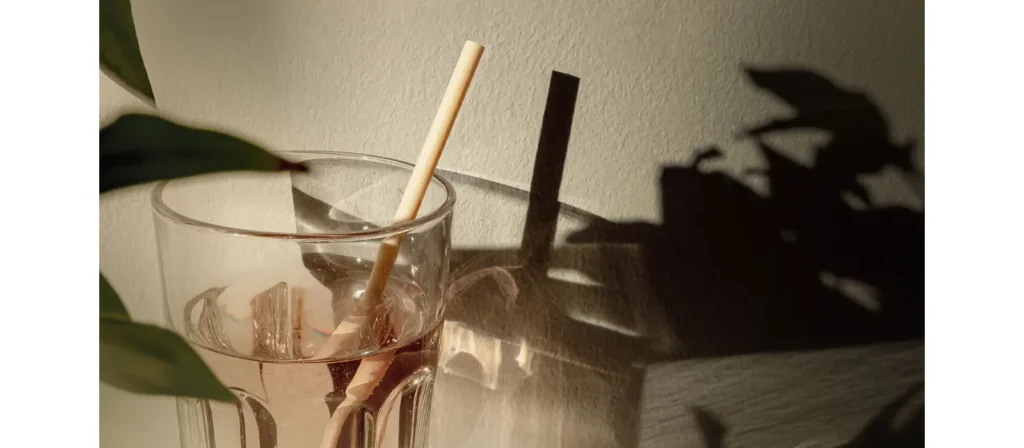
Use Cases:
Paper straws are commonly used in fast food chains, cafes, restaurants, hotels, and catered events. They are ideal for cold beverages such as water, soda, juice, or iced coffee. Because of their lightweight nature and short lifespan in liquids, they are typically meant for single-use and are not suited for hot drinks or extended use.
Pros:
- Readily biodegradable in a short time
- Cost-effective and widely available
- Accepted in most commercial composting programs
- Easy to print on for branding purposes
Cons:
- Tends to become soggy or collapse in liquid after 15–30 minutes
- Not suitable for hot drinks
- Some users find the texture unpleasant
- Requires extra packaging care to prevent moisture damage
2. Bamboo Straws
Bamboo straws are made from the hollow stems of naturally growing bamboo plants. They are handcrafted using minimal processing and do not require chemical treatments or artificial coatings. As a naturally antimicrobial and biodegradable material, bamboo offers an excellent alternative to plastic. Since each straw is cut directly from a stalk, no two are exactly alike, which adds to their rustic and eco-conscious appeal. Their reusability also makes them a preferred option for reducing overall waste.
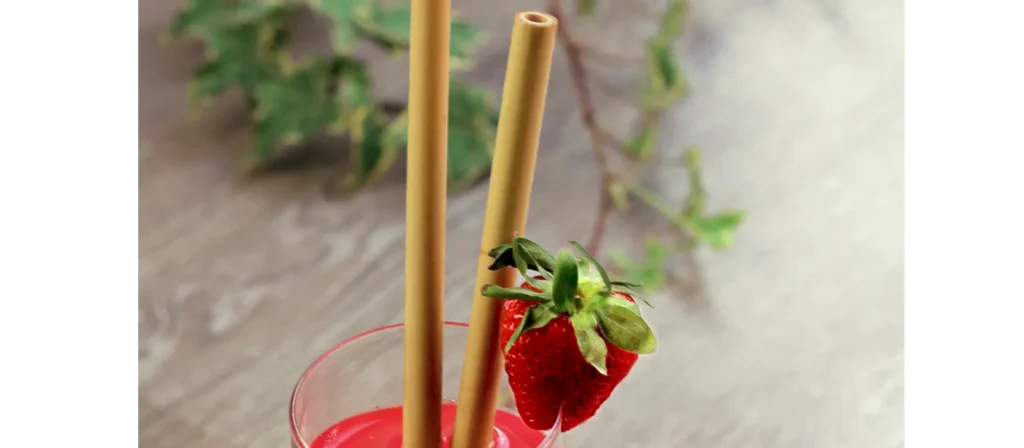
Use Cases:
Bamboo straws are ideal for cafes, juice bars, sustainable resorts, eco-themed events, and zero-waste households. They are well-suited for cold and room-temperature beverages including smoothies, fresh juices, coconut water, and iced coffee. With proper cleaning and care, bamboo straws can be reused multiple times, making them appropriate for personal daily use or environmentally friendly hospitality services.
Pros:
- Naturally biodegradable and compostable
- Reusable with proper care
- Strong and durable, suitable for thick or pulpy drinks
- Adds a premium, eco-friendly aesthetic
- Chemical-free and safe for food contact
Cons:
- Requires thorough cleaning and drying to prevent mold
- May develop minor surface cracks over time with repeated use
- Each straw may vary slightly in diameter and appearance
- Limited resistance to high heat, making them unsuitable for very hot beverages
3. Bagasse Straws (Sugarcane Straws)
Bagasse straws are made from the fibrous residue left behind after extracting juice from sugarcane. This material, known as bagasse, is a byproduct of the sugar industry and is fully biodegradable and compostable. By repurposing agricultural waste, bagasse straws turn what would otherwise be discarded into a functional and sustainable alternative to plastic. They are sturdy, smooth to the touch, and neutral in taste, making them a practical solution for businesses and consumers seeking environmentally responsible options without sacrificing usability.
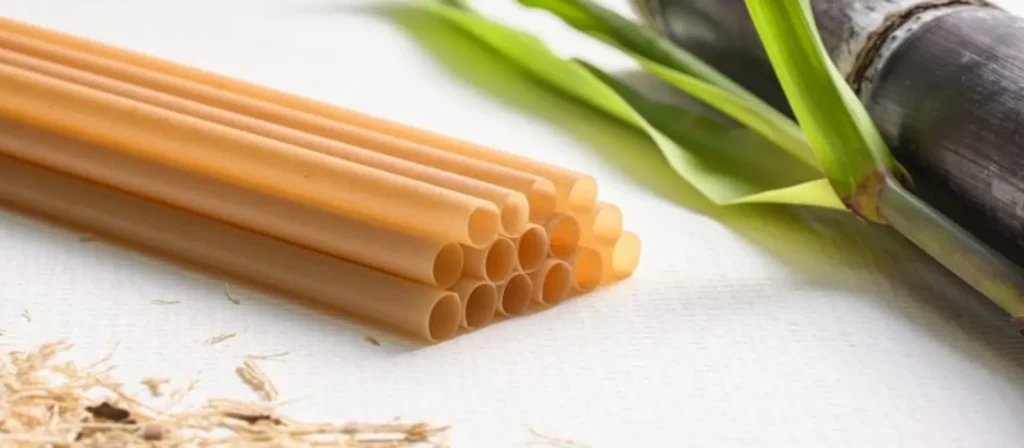
Use Cases:
Sugarcane straws are widely used in restaurants, cafes, catering services, and food delivery businesses. They perform well with a variety of beverages, including cold drinks, smoothies, juices, and even mildly warm beverages. Because they are designed for single-use and decompose naturally, they are especially popular among businesses aiming to reduce waste and comply with eco-friendly regulations.
Pros:
- Made from agricultural byproducts, supporting a circular economy
- Fully biodegradable and compostable in industrial and home composting environments
- Neutral taste and smooth texture that enhances the drinking experience
- Performs better in liquids than paper straws, with slower softening
- Compatible with cold and slightly warm beverages
Cons:
- Not suitable for very hot drinks due to limited heat tolerance
- Typically single-use and less durable than bamboo or PLA options
- Can be more expensive than paper straws due to limited production scale
- May soften slightly after extended contact with liquid
4. PLA Straws
PLA straws are made from polylactic acid, a bioplastic derived from renewable resources such as corn starch or sugarcane. Although they resemble traditional plastic straws in appearance and texture, PLA straws are biodegradable under specific conditions. They are designed to break down in industrial composting facilities that maintain high temperatures and controlled humidity levels. PLA is one of the most commercially available bioplastic materials and is frequently used by food service businesses looking to transition away from petroleum-based plastics.
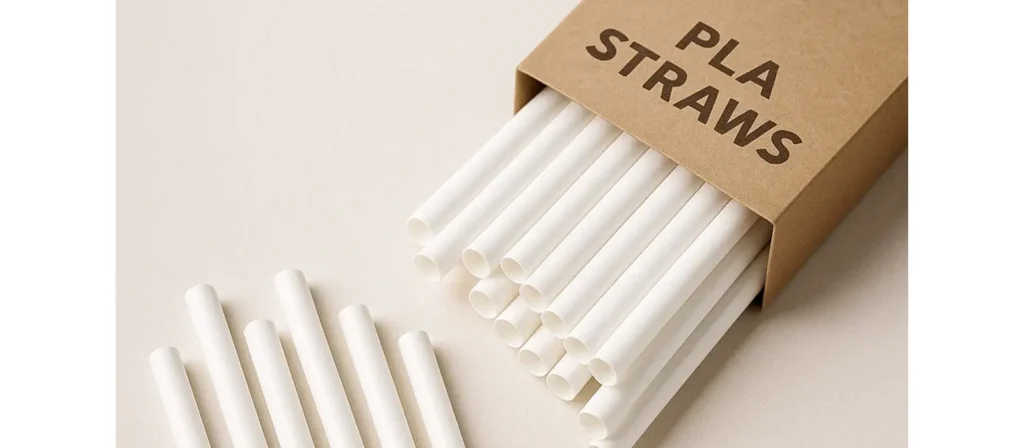
Use Cases:
PLA straws are commonly found in cafes, food courts, drink chains, and quick-service restaurants. Their durability and smooth texture make them ideal for cold drinks such as iced tea, smoothies, milkshakes, and bubble tea. While they are not suitable for hot beverages, PLA straws offer a user experience very similar to plastic, which makes them an easy swap for consumers and staff alike.
Pros:
- Made from renewable plant-based sources
- Visually and functionally similar to plastic, easing customer transition
- More durable than paper or wheat straws in cold beverages
- Suitable for large-scale food service operations
- Available in various sizes, colors, and shapes
Cons:
- Requires industrial composting facilities to break down effectively
- Not compostable in home or marine environments
- Cannot be recycled with traditional plastics
- Unsuitable for hot drinks as heat may cause softening or deformation
- May be mistakenly perceived as plastic, leading to improper disposal
5. PHA Straw
PHA straws are made from polyhydroxyalkanoates, a group of biodegradable polymers naturally produced by microbial fermentation of renewable resources such as plant oils, sugar, or starches. Unlike PLA, which requires industrial composting conditions, PHA can break down in a variety of environments including soil, freshwater, and marine ecosystems. This makes it one of the most advanced and truly biodegradable materials available for straw production. The result is a straw that looks and feels like plastic but leaves minimal environmental impact after disposal.
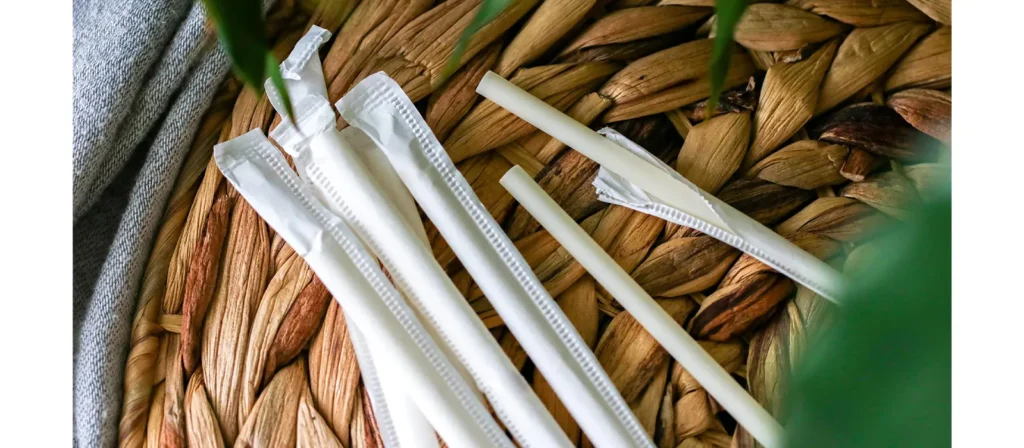
Use Cases:
PHA straws are particularly suitable for businesses that prioritize high-performance sustainability. They are ideal for restaurants, eco-resorts, event venues, and beverage brands aiming to comply with strict plastic bans while maintaining a familiar user experience. Their durability makes them compatible with both hot and cold drinks, and they are especially useful in regions without access to industrial composting facilities.
Pros:
- Breaks down in natural environments including water and soil
- Certified marine biodegradable and home compostable
- Strong and flexible with excellent performance in hot or cold drinks
- Odorless and tasteless, similar to traditional plastic straws
- Ideal for areas with limited composting infrastructure
Cons:
- Higher production cost compared to PLA or paper straws
- Limited global supply due to relatively new production technology
- Not yet widely available in all markets
- May be over-engineered for basic single-use scenarios
- Requires careful sourcing to ensure certification authenticity
6. Wheat Straws
Wheat straws are made from the leftover stalks of wheat plants after the grain has been harvested. These stalks, once considered agricultural waste, are now repurposed into thin, hollow drinking straws without the need for additives or chemical treatments. As a completely natural material, wheat straws are biodegradable, compostable, and often even edible, depending on how they are processed. Their minimal manufacturing footprint and zero-waste nature make them a highly sustainable choice for single-use applications.
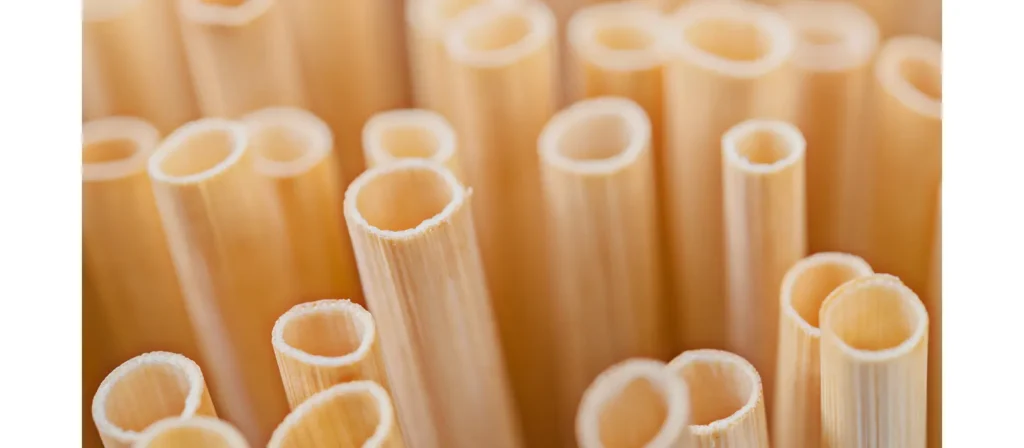
Use Cases:
Wheat straws are best suited for cafes, eco-friendly events, food festivals, and small beverage businesses that serve light drinks such as juices, cocktails, soft drinks, or water. They are typically used with cold or room-temperature beverages and are ideal for consumers looking for an organic, plant-based option. Their slim design also makes them a good match for lightweight drink packaging.
Pros:
- Fully biodegradable and compostable in natural environments
- Made from agricultural byproducts with no added chemicals
- Lightweight and naturally water-resistant for short-term use
- Adds a natural, rustic aesthetic to drink presentation
- Suitable for compost bins, home gardens, and commercial composting
Cons:
- Fragile and not suitable for thicker drinks like smoothies or milkshakes
- Uniform size may not fit all lid types or drink containers
- Limited durability, especially after prolonged exposure to liquid
- Not recommended for hot beverages due to potential softening
- May break or crack under pressure or if bent
7. Agave Straws
Agave straws are made from the residual fibers of the agave plant, which remain after the extraction of agave syrup or tequila. These fibers are processed and molded into sturdy straws that offer a sustainable alternative to plastic. Since agave is already widely cultivated for commercial use, producing straws from its byproducts helps reduce agricultural waste. The texture and appearance of agave straws closely resemble traditional plastic, yet they are fully biodegradable and can break down in composting environments over time.
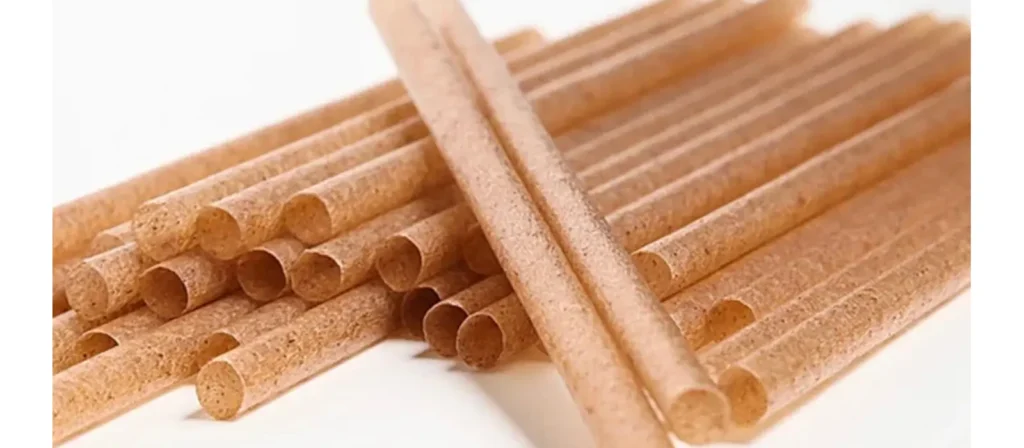
Use Cases:
Agave straws are well-suited for restaurants, bars, beverage distributors, and eco-conscious hospitality brands. Their strength and versatility make them ideal for both cold and moderately warm beverages, including cocktails, iced teas, and lemonades. They are a practical choice for venues that want the performance of plastic without the environmental impact.
Pros:
- Made from renewable agricultural byproducts
- Strong and durable, with performance similar to plastic straws
- Biodegradable under composting conditions
- Neutral in taste and odor, enhancing beverage enjoyment
- Helps reduce waste from tequila and agave syrup production
Cons:
- Not suitable for hot drinks due to potential softening
- Requires industrial composting to decompose efficiently
- May not be widely available in all regions
- Slightly higher cost compared to paper or wheat straws
- Limited customization options compared to plastic-based alternatives
8. Rice Straws
Rice straws are made from a mixture of rice flour and tapioca starch, sometimes blended with other natural binders. These straws are extruded and dried into solid shapes that resemble plastic but are fully biodegradable and often even edible. Popularized in parts of Asia, rice straws offer an innovative and visually appealing solution to single-use plastic straws. They come in various colors and sizes and are often marketed as safe, non-toxic, and environmentally friendly.
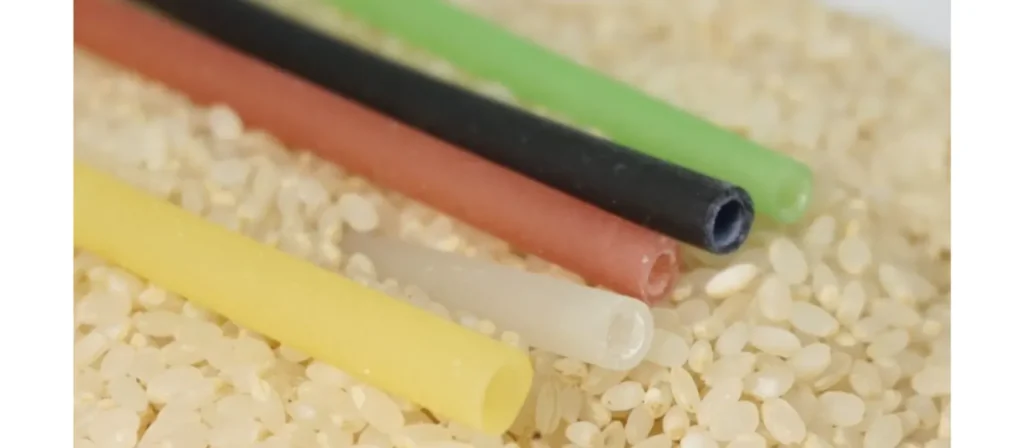
Use Cases:
Rice straws are ideal for cafes, bubble tea shops, juice bars, and event venues seeking both sustainability and visual appeal. They perform well in cold drinks such as fruit juices, smoothies, and iced teas. Due to their edible nature and attractive appearance, they are often used for novelty or themed presentations, especially in eco-conscious foodservice environments.
Pros:
- Made from food-grade ingredients and fully biodegradable
- Edible and safe for both adults and children
- Offers better drink durability than paper straws
- Naturally decomposes in compost or landfill conditions
- Available in multiple colors, adding visual appeal
Cons:
- Limited lifespan in liquid, usually maintaining structure for 30 to 60 minutes
- Not suitable for hot beverages as heat may cause softening
- Slightly higher cost due to food-grade ingredients
- Can become brittle if stored in overly dry environments
- Requires careful handling during packaging and transport
9. Palm Leaf Straws
Palm leaf straws are crafted from the fallen leaves of the areca palm tree, which are collected, cleaned, and naturally pressed into shape without the use of chemicals or synthetic binders. This makes them one of the most eco-friendly and truly natural straw options available. Each straw has a slightly textured, wood-like appearance, offering a rustic and organic aesthetic. Since no trees are cut down during production and the process requires minimal water and energy, palm leaf straws are a highly sustainable option.
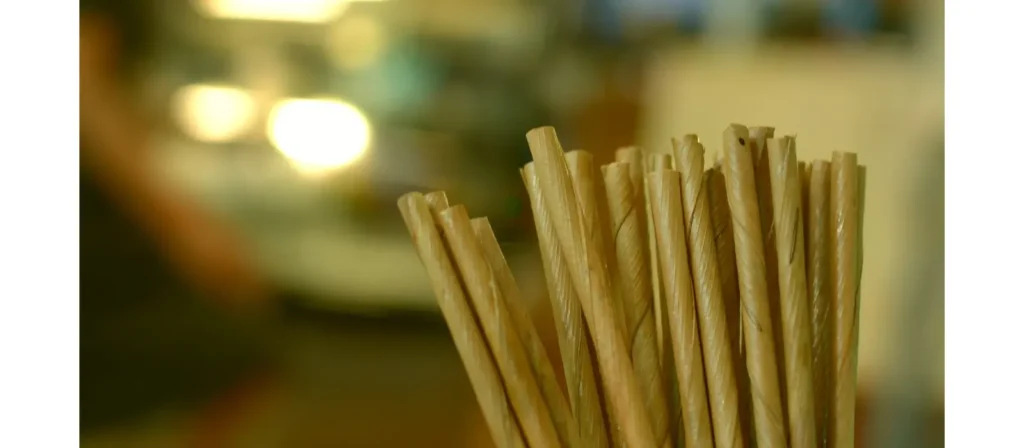
Use Cases:
Palm leaf straws are particularly suitable for eco-lodges, outdoor events, farm-to-table restaurants, and sustainable resorts that want to provide a high-end, natural drinking experience. They are ideal for cold beverages such as herbal teas, fresh juices, cocktails, and mineral water. Their distinct appearance also makes them a popular choice for themed events and environmentally focused branding.
Pros:
- Made from 100 percent naturally fallen palm leaves
- Chemical-free, compostable, and fully biodegradable
- Unique texture and appearance enhance presentation
- Durable in cold and room-temperature drinks
- Low-impact manufacturing process with minimal waste
Cons:
- Not recommended for hot beverages due to structural sensitivity
- May absorb liquid slightly over time if left in drink too long
- Limited size and shape variations compared to molded straws
- Higher cost due to manual collection and processing
- Not yet widely available in all global markets
10. Grass Straws
Grass straws are made from a specific species of wild grass known as Lepironia articulata, which is native to wetland areas in Southeast Asia. These straws are harvested, cleaned, cut, and sun-dried using traditional, chemical-free methods. The natural hollow structure of the grass makes it an ideal shape for drinking straws without the need for artificial shaping or processing. Grass straws are completely plant-based, biodegradable, and compostable, offering one of the most natural and low-impact alternatives to plastic.
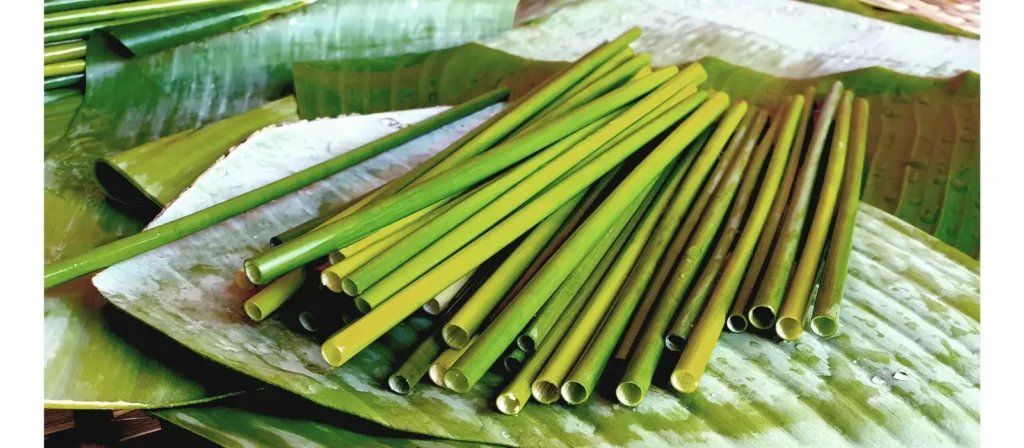
Use Cases:
Grass straws are commonly used in eco-resorts, sustainable cafes, wellness retreats, juice bars, and organic restaurants that want to elevate the natural experience of their offerings. They are best suited for cold and room-temperature drinks such as herbal teas, fruit-infused water, fresh juices, and cocktails. Their rustic appearance and completely natural origin make them ideal for businesses that emphasize environmental values.
Pros:
- Made from wild grass with no added chemicals or coatings
- Fully compostable and safe for home or industrial composting
- Naturally antimicrobial and safe for direct food contact
- Adds a unique and rustic look to beverage presentation
- Lightweight, renewable, and harvested with minimal environmental disruption
Cons:
- Limited shelf life if not stored in dry conditions
- Not suitable for hot beverages due to risk of softening or splitting
- Inner diameter may vary slightly between straws
- More fragile than PLA or bamboo alternatives
11. Coconut Leaf Straws
Coconut leaf straws are handcrafted from the dried, fallen leaves of the coconut palm tree. The leaves are collected, cleaned, rolled, and shaped into tubular forms without the use of glue, dyes, or synthetic materials. This production process is entirely natural and typically carried out by artisans in rural communities, which supports both environmental conservation and local employment. The result is a sturdy, biodegradable straw that reflects traditional craftsmanship and sustainable values.
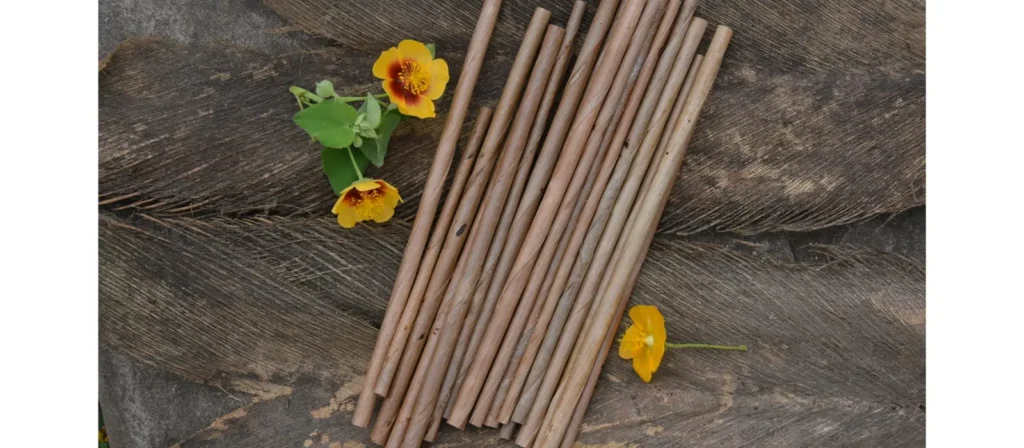
Use Cases:
Coconut leaf straws are often used in eco-resorts, organic cafes, nature-based events, tropical-themed parties, and environmentally focused catering services. Their structure is suitable for cold and room-temperature beverages such as smoothies, fruit juices, herbal drinks, and water. These straws are especially appealing in settings that value natural aesthetics and ethical sourcing.
Pros:
- Made from naturally fallen coconut leaves, with no chemicals or plastic
- Fully biodegradable and compostable in home or commercial composting systems
- Durable and reusable several times with proper cleaning
- Offers a natural, earthy appearance that enhances drink presentation
- Supports traditional craft and rural economic development
Cons:
- Not suitable for hot beverages due to possible softening or warping
- Slight variations in shape and thickness due to handcrafting
- May absorb some liquid over time if left submerged
- Limited mass production capacity compared to industrial straws
- Requires dry storage to avoid mold or moisture damage
Tips for Choosing Biodegradable Straws
Choosing the right biodegradable straw involves more than simply picking a product labeled as eco-friendly. It requires thoughtful evaluation of several practical and environmental factors to ensure the choice aligns with the intended use and sustainability goals. Below are some key considerations to guide your decision-making process:
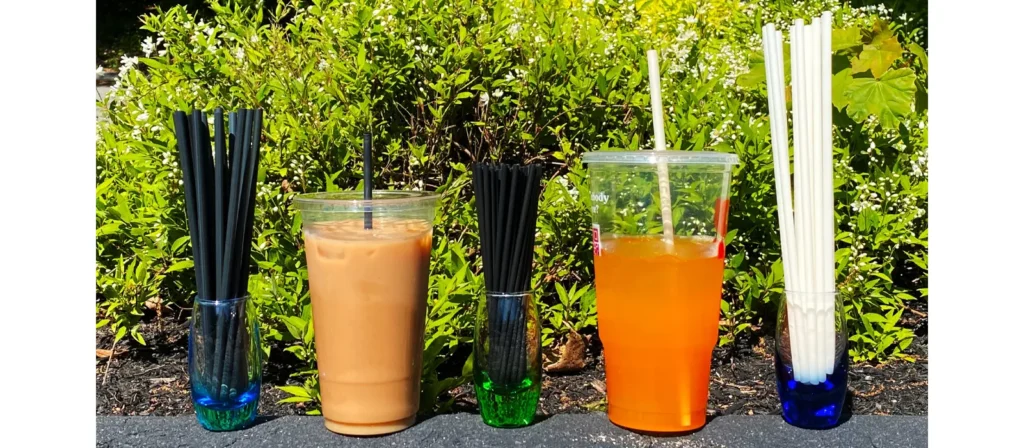
1. Understand the Usage Context
Before selecting a biodegradable straw, consider where and how it will be used. Factors such as beverage type, duration of use, target audience, and setting all influence which straw characteristics are most important. For example, straws used in quick-service environments may require different features than those intended for formal dining or events.
2. Assess Composting or Disposal Options
Not all biodegradable materials break down in the same way. Some require industrial composting facilities, while others can decompose naturally in home compost or landfill environments. Evaluate the waste disposal systems available in your area and choose a straw that matches those conditions to avoid unintended waste accumulation.
3. Evaluate Functional Requirements
Think about the physical demands placed on the straw. Consider durability, liquid temperature, and drink thickness. A straw that performs well in one context may not be suitable for another. Understanding these functional needs helps narrow your options to the most practical choices.
4. Conduct Usability Testing Before Full Adoption
Before committing to a specific straw type, test it in real-world conditions. Observe how long it maintains structure in various drinks, whether it alters taste or texture, and how it fits with your existing packaging or lids. Gathering user feedback during this testing phase can help identify performance issues early and avoid customer dissatisfaction.
5. Consider Shelf Life and Storage Conditions
Biodegradable straws often have different storage requirements compared to plastic ones. Exposure to moisture, humidity, or sunlight can affect their quality. Check storage guidelines and shelf life before placing large orders to prevent spoilage or product failure.
6. Review Certifications and Material Transparency
Look for third-party certifications that verify biodegradability or compostability. Reputable suppliers will typically provide documentation about the materials used and disposal standards, which helps avoid misleading environmental claims.
7. Balance Sustainability with Practicality
While minimizing environmental impact is important, ease of use and customer experience also matter. A straw that aligns with your sustainability goals but frustrates users may result in wasted resources and reputational risk. The ideal choice finds a balance between ecological responsibility and functional performance.
Where Can You Get Biodegradable Straws?
As the demand for sustainable products grows, biodegradable straws have become widely available in both physical stores and online marketplaces. Whether you are an individual looking for eco-friendly options for daily use or a business aiming to meet sustainability goals, finding the right straws is easier than ever.
1. Directly from Manufacturers like Million Pack
Sourcing biodegradable straws directly from manufacturers ensures product quality, consistency, and the possibility of custom solutions. Million Pack is a trusted manufacturer and global supplier of eco-friendly food packaging, offering a wide range of biodegradable straws including paper, PLA, sugarcane, wheat, and rice straws. With over 16 years of experience, Million Pack provides:
- Reliable bulk supply and global distribution
- Custom packaging and private label services
- International certifications and food-grade compliance
- One-stop support from design to delivery
2. Local Distributors or Wholesalers
E-commerce platforms like Amazon or Etsy provide a wide range of biodegradable straws in different materials and pack sizes. These platforms are convenient for comparing brands, reading customer reviews, and finding both consumer and bulk options.
3. Eco-friendly Businesses
Sustainable lifestyle shops often curate compostable products, including biodegradable straws made from paper, wheat, or bamboo. These stores may also offer education on proper disposal or composting methods.
4. Online Marketplaces
E-commerce platforms provide convenient access to biodegradable straws in various materials and sizes. However, quality and certification may vary, so be sure to review seller credentials carefully.
5. Specialty Shops
Stores focused on organic goods, zero-waste living, or environmentally conscious home products often include biodegradable straws in their reusable or disposable product lines. These shops may prioritize ethically sourced materials.
6. Supermarkets
Larger supermarket chains may carry biodegradable straws in their household goods or natural products aisle. Availability can vary by location, but seasonal and branded eco-products are becoming more common.
FAQs
- How long do biodegradable straws take to decompose?
Most biodegradable straws break down within weeks or months, depending on the material. Paper straws decompose quickly, while PLA straws may need industrial composting and take longer. All types of biodegradable straws degrade far faster than plastic. - Do biodegradable straws cost more than plastic straws?
In most cases, biodegradable straws are slightly more expensive than plastic straws due to the cost of sustainable materials and production processes. However, as demand increases and more options become available, prices are becoming more competitive, especially when purchased in bulk. - Are biodegradable straws suitable for hot drinks?
Most biodegradable straws are not ideal for hot beverages. Materials like paper, wheat, and rice tend to soften or lose shape when exposed to high temperatures. Some options, such as PLA, may also deform or release microplastics if used with hot liquids. If you need a straw for warm or hot drinks, consider more heat-resistant alternatives like specially treated bamboo or PHA straws. Always check the product’s temperature tolerance before use. - What is the difference between compostable and biodegradable?
Biodegradable items naturally break down over time, while compostable items not only decompose but also enrich the soil. All compostable straws are biodegradable, but not all biodegradable straws are compostable. - Do biodegradable straws affect the taste of the drink?
Generally, high-quality biodegradable straws do not alter the taste of the beverage. However, some natural materials like grass or wheat may add a subtle flavor, especially in warm or acidic liquids. - Are biodegradable straws reusable?
Most biodegradable straws are designed for single use. However, certain types such as bamboo or coconut leaf straws can be cleaned and reused several times with proper care.
Conclusion
As awareness of plastic pollution continues to grow, biodegradable straws have become a meaningful step toward more sustainable consumption. From paper and PLA to bamboo, rice, wheat, and sugarcane, each type of straw offers different advantages depending on your needs, disposal methods, and environmental goals.
Selecting the right biodegradable straw requires careful consideration of durability, compostability, material origin, and use conditions. With so many options available, the best choice is one that balances performance with ecological impact.
If you’re unsure which type is most suitable for your business or event, we encourage you to reach out to us. Million Pack specializes in sustainable food packaging solutions, including biodegradable straws, takeaway containers, paper cups, and more. With over 16 years of experience, we are committed to helping you find packaging that aligns with your environmental values and functional needs.
Making the switch to biodegradable straws is a small but impactful step. When done thoughtfully and responsibly, it contributes to a cleaner, greener future for everyone.

